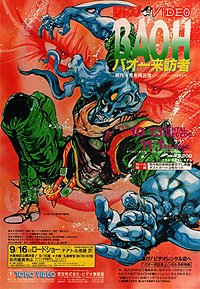Baô Raihôsha |
|
Japan • 1989 • 50m •
     • Directed by: Hiroyuki Yokoyama. • Starring: Jim Clark, Sandy Clubb, Chuck Denson Jr., Mark Franklin, Kevin Greenway, Kimberly Helms Stewart, Noriko Hidaka, Brian Hinnant, Hiroyuki Hori, Patrick Humphrey, Shûichi Ikeda, Yô Inoue, Paul Johnson.. • Directed by: Hiroyuki Yokoyama. • Starring: Jim Clark, Sandy Clubb, Chuck Denson Jr., Mark Franklin, Kevin Greenway, Kimberly Helms Stewart, Noriko Hidaka, Brian Hinnant, Hiroyuki Hori, Patrick Humphrey, Shûichi Ikeda, Yô Inoue, Paul Johnson..    Doress, a Japanese ''black projects'' organization, has been gathering psionics and making biological weapons to ''make Japan superior''. When one of the biological experiments, BAOH, escapes with a young girl, Doress will do anything to get the boy and girl back. For BAOH is a parasite living in its host's brain, altering the host into a living death machine in order to keep it alive. When Doress sends assassins after the boy and girl, BAOH ''awakens'' to its ''Armed Defense Phenomenons'', giving the boy acid-tipped claws, bio-regeneration, and super-strength. But Doress takes the girl, and BAOH must fight an army of commandos and a psionic to get her back. Doress, a Japanese ''black projects'' organization, has been gathering psionics and making biological weapons to ''make Japan superior''. When one of the biological experiments, BAOH, escapes with a young girl, Doress will do anything to get the boy and girl back. For BAOH is a parasite living in its host's brain, altering the host into a living death machine in order to keep it alive. When Doress sends assassins after the boy and girl, BAOH ''awakens'' to its ''Armed Defense Phenomenons'', giving the boy acid-tipped claws, bio-regeneration, and super-strength. But Doress takes the girl, and BAOH must fight an army of commandos and a psionic to get her back.
|
Review:















The plot involves an experiment by Doress, a secret corporate group--with government ties, of course--which results in a 17-year-old boy being given superhuman powers that continue to evolve and get more powerful each time he is attacked. The boy, Ikuro Hashizawa, escapes custody from a moving train and eludes military pursuers thereafter with the help of a nine-year-old psychic girl, Sumire, who is also sought after by Doress. Each time the pursuers catch up to them, Ikuro, under the growing power of Baoh--the name given the lab-created entity implanted in the boy--transforms into an increasingly sophisticated monstrous killing machine and plows through the bad guys with lethal precision, slicing, dicing and decapitating--in bright primary colors--as he goes. Eventually, the girl is abducted, forcing Ikuro to seek her out in the organization's underground headquarters and storm his way through their defenses, including a giant American Indian warrior named Walken who puts up the most brutal fight Baoh has ever faced.
The animation follows the lead of the manga pretty closely, not only in the actual events of the story, but the design of the characters and the style of the action and violence. The only major difference is the cutting of some of the incidents that happen during the two lead characters' flight to freedom. Made in 1989, BAOH relies on the strong suits of the animation of that period--bright colors, bold, strong lines and clear, straightforward, detailed design.
Review by Brian Camp from the Internet Movie Database.
Movie Database
